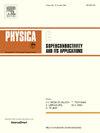CiADS项目中斜余弦超导四极磁体的设计与试验
IF 1
3区 物理与天体物理
Q4 PHYSICS, APPLIED
Physica C-superconductivity and Its Applications
Pub Date : 2025-01-21
DOI:10.1016/j.physc.2024.1354646
引用次数: 0
摘要
在中国倡议的加速器驱动系统(CiADS)项目中,设计了一种最先进的悬臂-余弦-θ(CCT)超导四极磁体,用于紧凑型直列加速器。原型磁场梯度为 40 T/m,在效率和性能方面将超越传统的普通传导设计。该四极杆由两个铝合金成型器组成,能产生孔径为 60 毫米的高质量四极杆。十根用尼龙编织物绝缘的铌钛导线缠绕在由计算机数控(CNC)加工的矩形槽中。槽宽 2 毫米,深 5 毫米。本文介绍了基于 CCT 概念的详细设计,并报告了磁体原型的制造和线圈绕制。最后,磁场测量是在液氦冷却的低温试验槽中进行的。由于拼接接头的阻力,磁体的电流裕度达到 54%。本文章由计算机程序翻译,如有差异,请以英文原文为准。
Design and test of a canted-cosine-theta superconducting quadrupole magnet for CiADS project
For the China Initiative Accelerator Driven System (CiADS) Project, a state-of-the-art Canted-Cosine-Theta (CCT) superconducting quadrupole magnet has been designed to compact the linac. The prototype, with a magnetic field gradient of 40 T/m, is set to eclipse the conventional normal-conducting designs in terms of efficiency and performance. This quadrupole consists of two aluminum alloy formers that produce a high quality quadrupole, with a bore diameter of 60 mm. Ten NbTi wires, insulated with Nylon braid, are wound into the rectangular grooves that are machined by computer numerical control (CNC). The size of grooves is 2 mm wide and 5 mm deep. This paper describes the detailed design based on the CCT concept and reports on the fabrication and coil winding of the magnet prototype. Finally, the magnetic field measurements are carried out within a cryogenic test bath cooled with liquid helium. Due to the resistance of splice joints, the magnet reached 54 % of current margin.
求助全文
通过发布文献求助,成功后即可免费获取论文全文。
去求助
来源期刊
CiteScore
2.70
自引率
11.80%
发文量
102
审稿时长
66 days
期刊介绍:
Physica C (Superconductivity and its Applications) publishes peer-reviewed papers on novel developments in the field of superconductivity. Topics include discovery of new superconducting materials and elucidation of their mechanisms, physics of vortex matter, enhancement of critical properties of superconductors, identification of novel properties and processing methods that improve their performance and promote new routes to applications of superconductivity.
The main goal of the journal is to publish:
1. Papers that substantially increase the understanding of the fundamental aspects and mechanisms of superconductivity and vortex matter through theoretical and experimental methods.
2. Papers that report on novel physical properties and processing of materials that substantially enhance their critical performance.
3. Papers that promote new or improved routes to applications of superconductivity and/or superconducting materials, and proof-of-concept novel proto-type superconducting devices.
The editors of the journal will select papers that are well written and based on thorough research that provide truly novel insights.

 求助内容:
求助内容: 应助结果提醒方式:
应助结果提醒方式:


